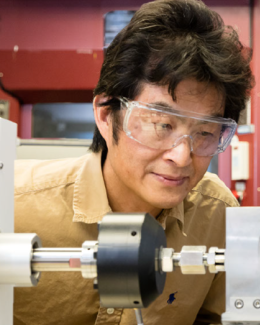Topic:
The U.S. Department of Energy’s Water Power Technologies Office (WPTO) highlighted several Oak Ridge National Laboratory (ORNL) projects in its recently released 2021-2022 Accomplishments Report.
The report highlights WPTO’s work with partners across the country, to advance hydropower and marine energy technologies. The objective of these projects is to help realize water power’s full potential to contribute to a carbon-free power sector by 2035 and a net-zero-emissions economy by 2050 in the United States.
Out of approximately 40 projects featured in the year-end report, six of ORNL’s Water Power Program projects were specifically lauded.
- As the name implies, the Standard Modular Hydropower (SMH) Technology Acceleration project is facilitating a national-scale transformational approach to new hydropower development across the US. ORNL developed the new waterSHED tool to help stakeholders in the hydropower industry navigate a new pathway for hydropower development. ORNL’s ongoing research into standard modular hydropower provides broadly accessible templates that outline comprehensive, validated strategies for developing SMH facilities under a variety of deployment scenarios.
- The Non-powered Dam Development Opportunities Assessment project has several initiatives underway at ORNL, including standard modular hydropower, pumped storage FAST commissioning, and the feasibility and economic analysis of modular pumped storage. These efforts and the lab’s new suite of online tools may enable industry partners make more informed decisions on the feasibility, risks, and potential benefits of pursuing an R&D strategy that reduces the costs of traditional pumped storage hydropower facilities.
- The National Conduit Resource Assessment project seeks to identify and assess the potential for new hydropower development along existing conduits that traverse across the US in water supply pipelines, wastewater discharge, agricultural irrigation, and cooling water discharge from thermoelectric power plants. ORNL’s report identified conduit potential in every state of the country, with the highest total capacity potential in California, followed by Colorado, Washington, Nebraska, and Oregon.
- ORNL partnered with other national labs and project lead Natel Energy in the Restoration Hydro: A Watershed Approach to Standard Modular New Hydropower project to develop a modular hydropower concept that can help expand hydropower while supporting safe fish passage, river channel connectivity, and watershed restoration efforts. ORNL’s NPD retrofit design, new NPD Explorer App, and NPD custom analysis and taxonomy app will facilitate knowledge sharing across the industry and support more informed decision-making. ORNL’s tools are further defined here.
- For the Digital Twin for Hydropower Systems Open Platform Framework ORNL and Pacific Northwest National Laboratory (PNNL) co-led a multi-disciplinary effort to develop a one-dimensional model of a hydropower digital twin, virtually representing a test unit in Norway. Digital twins in hydropower aim to modernize an aging hydropower fleet by mimicking the behavior of real plants and then taking that data to accurately model the plant’s performance in real time. Using artificial intelligence tools, digital twins may provide insights that can increase operational efficiency, reduce operation costs, improve asset management, and provide resiliency.
- For the Hydropower Supply Chain Deep Dive Assessment project, ORNL conducted a series of supply chain assessments, culminating in a report that identified the impacts of a burdened supply chain on the hydropower sector. While the current supply chain adequately supports the existing US hydropower fleet, the industry should prepare for longer lead times in procuring components for new construction and modernization efforts in response to growing demand for hydropower. – Mimi McHale
Media Contact
Kimberly Askey
, Communications Coordinator, Biological and Environmental Systems Science Directorate
, 865.576.2841
|
ASKEYKA@ORNL.GOV








